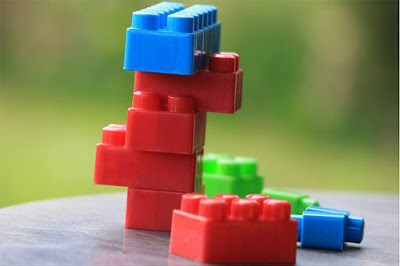
|
Mother Pelican
A Journal of Solidarity and Sustainability
Vol. 16, No. 7, July 2020
Luis T. Gutiérrez, Editor
|
|
|
|

|
|
|
The World as a Giant Lego Tower
Federico Tabellini
This article was originally published in
Cassandra's Legacy, 1 June 2020
under a Creative Commons License

Over the history of the Lego company, more than 600 billion plastic bricks have been produced, which means about a hundred bricks for every living person on Earth. Impressive, but it amounts to only 1.5 Gt of carbon in total (2.5 grams per brick), that is about 15% of the yearly carbon emissions produced by burning fossil fuels. Of course, being the bricks solid, they won't contribute to global warming, but they will slowly degrade and enter the food chain. Our descendants (if there will be any) will eat the toys we played with! But, here, Federico Tabellini is not discussing the pollution caused by Lego bricks but uses them as a metaphor for our society.
|
The lego brick that constitutes the foundation of the tower has a fixed number and distribution of holes (we did not choose these: they were already there when we opened the box, and at the moment the toy store has no other boxes for sale). It follows that the smaller bricks that we add on top of it, which give shape to the tower, interlock with the foundation brick only if their ledges are compatible with its holes.
The stability of the tower, they say, is a function of the compatibility of the bricks with one another and with the structure as a whole. The most important brick is of course the one at the bottom. By forcing incompatible bricks into the foundation brick over and over, with time we can damage its holes, to the point where even bricks that once would have been perfectly compatible with it would give the tower sub-optimal results in terms of stability.
Inside the box we found a small manual (the kind that nobody ever reads). It contains some definitions useful to building and maintaining the tower.
Definitions
Mainstream economics: the idea that the bricks in the box are scarce but the possibilities infinite.
Green economy: the idea that among the infinite possibilities of mainstream economics, there is a way of making the scarce bricks infinitely reusable.
Consumerism: the idea that the bricks are infinite, and can thus be wasted. Paradoxically, this idea is based on the belief that the bricks in the box are scarce but the possibilities infinite.
Modernity: the historical age when: a) the tower reached its maximum height and b) the idea that in the future it could be even higher was universally accepted. Also: a time when people thought that a higher tower was a good thing, regardless of any other considerations.
Post-modernity: the historical age when people devoted most of their time and energy to decorating the tower because its stability was mistakenly taken for granted. Many wanted to build their own little personal towers, while others reminisced about a time without towers. The certainties crumbled, and all the bricks started to look indistinguishable from one another. Thus the personalization of the bricks became a need, and everyone longed for their own unique piece.
Degrowth: the idea that the tower is not stable because it is too tall. The proposal of a new equation: stability as a function of both the compatibility of the bricks with one another and the height of the tower.
Buen vivir: the idea that a shorter tower is not necessarily a worse tower.
Resilience: the capability of the holes of the foundation brick to return to their original state after the forceful insertion of an incompatible brick. It seems this capability is not inexhaustible.
Contemporary politics: the idea that the tower’s height needs to grow so that everybody can enjoy a nice view VS the idea that the tower’s height needs to grow so that somebody can enjoy a magnificent view.
Third world: the place where many of the tower’s bricks were produced.
First world: the place where the tower reached its maximum height.
Society, definition 1: the tower.
Society, definition 2: the totality of the individual and collective ideas and practices through which the following functions (among others) are carried out: building the tower; maintaining the tower; living in the tower; coordinating the various floors of the tower.
Ecosystem: the tower’s foundation brick.
On the last page of the manual, a warning note reads:
“Do not damage the foundation brick excessively: its reparation requires uncountable tons of star dust, a few billion years and a considerable amount of luck.”
|
ABOUT THE AUTHOR
Federico Tabellini is the author of A Future History of the 21st Century: How We Overcame the Crisis of Civilization. For years he has been interested in environmental, economic, and social issues. In the past he has published three papers on issues related to degrowth: "Degrowth and Sustainable Human Development: in search of a path toward integration" (paper presented at the International Conference on Degrowth, Venice 2012); "Human development and environmental sustainability: seeking a road to integration" (winner of the first edition of the "Giorgio Rota Best Paper Award," Research and Documentation Center Luigi Einaudi, 2013) and "From growth to degrowth to a steady-state economy: a (more) liberal path is possible" (available on ASR and online, 2019). He holds a degree in political science, sociology, and applied linguistics. He currently lives in Barcelona.
|
|
|
|
|
"The usefulness of a cup is in its emptiness."
Old Chinese Proverb
|
|
Page 2
|
|
FREE SUBSCRIPTION
|
![[groups_small]](groups_small.gif)
|
Subscribe to the
Mother Pelican Journal
via the Solidarity-Sustainability Group
Enter your email address:
|
|
|
|